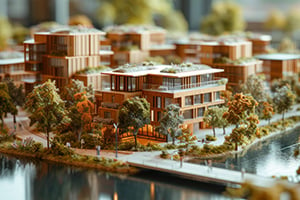By Devin Takekawa
Engineering Analyst
Sustainable Investment Group (SIG)
South Dakota State University, also known as SDSU, has been committed to making sustainability and energy conservation efforts since the early 2000s. The SDSU campus in South Dakota is about 332 acres large, hosts over 11,000 students, and has 12 LEED certified buildings. The Dykhouse Student-Athlete Center, Mathematics and Engineering building, and Architecture building are a few examples of their LEED certified buildings. Adding to the list of SDSU green buildings is Harding Hall, which was originally constructed in 1954 as a men’s residence hall. After undergoing major renovations, Harding Hall is now a 24,788 SF academic building for the Ness School of Management and Economics. On March 30th, 2020, the USGBC awarded Harding Hall with a LEED v4 BD+C Gold certification for their building design and major renovations.
Many of the renovations that were implemented at Harding Hall helped SDSU earn their LEED Gold certification because they were energy efficient and sustainable solutions. One of the major highlights from the renovation was that new plumbing fixtures were installed in the building. This upgrade has already been reducing the water use to over 40% less than it previously operated at.
Also, the building engineers decided to use chilled beam technology, which is mainly used to cool the building during the warm seasons. Chilled beam technology operations are energy efficient and can be slightly better than the VAV boxes that we know today. The chilled beam takes advantage of natural convection flow for hot air in the building. As hot air rises, it enters into the chilled beam system where it is recycled and passed through a “chiller” that cools the hot air. The cool air will naturally fall back down into the operating space which allows the HVAC system to not use as much energy and in fact has improved Harding Hall’s energy efficiency by 27.8%. (Example of a chilled beam system can be seen in Figure 2)
Besides installing these energy efficient systems, the Harding Hall project team also kept in mind to reuse as much of the previous building structure as possible. The team was able to recycle almost 80% of the material from the building structure which led to almost earning all of the points for the LEED credit: Building life-cycle impact reduction.
Harding Hall at South Dakota State University is a great example of college campuses taking initiative towards their impact on the environment and being invested into sustainability. We would like to recognize and thank the Harding Hall project team: Clark Drew Construction, JLG Architects, West Plains Engineering, Questions & Solutions Engineering, CDI, and the Sustainable Investment Group (SIG)!
There is an increasing amount of green and sustainable buildings being constructed and renovated on college campuses across the nation, more than ever. As we can see with Harding Hall, college campus buildings are also beginning to apply for LEED certifications. Feel free to reach out us, Sustainable Investment Group (SIG), if we can help your green building become LEED certified or if you have any questions about LEED in general!
Credits:
https://sigearth.com/
https://www.sdstate.edu/sustainability/energy-conservation
Figure 1:
https://www.sdstate.edu/news/2019/12/harding-hall-renovation-receives-award
Figure 2:
https://www.designerpages.com/products/4267881/
Figure 3:
https://jlgarchitects.com/projects/harding-hall-renovation/
https://clarkdrewconstruction.com/project/sdsu-harding-hall/
© 2020 Sustainable Investment Group (SIG). All rights reserved.



